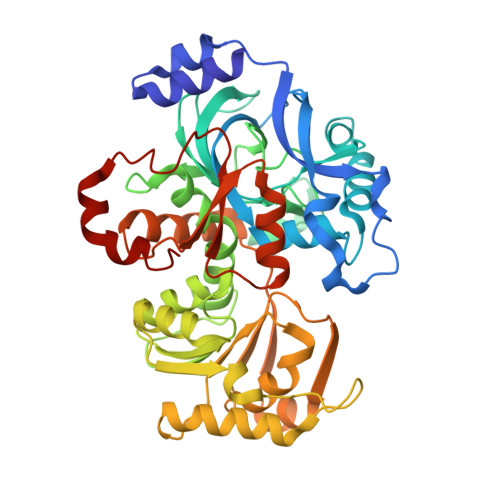Four amino acids define the CO2binding pocket of enoyl-CoA carboxylases/reductases.
Stoffel, G.M.M., Saez, D.A., DeMirci, H., Vogeli, B., Rao, Y., Zarzycki, J., Yoshikuni, Y., Wakatsuki, S., Vohringer-Martinez, E., Erb, T.J.(2019) Proc Natl Acad Sci U S A 116: 13964-13969
- PubMed: 31243147
- DOI: https://doi.org/10.1073/pnas.1901471116
- Primary Citation of Related Structures:
6OWE - PubMed Abstract:
Carboxylases are biocatalysts that capture and convert carbon dioxide (CO 2 ) under mild conditions and atmospheric concentrations at a scale of more than 400 Gt annually. However, how these enzymes bind and control the gaseous CO 2 molecule during catalysis is only poorly understood. One of the most efficient classes of carboxylating enzymes are enoyl-CoA carboxylases/reductases (Ecrs), which outcompete the plant enzyme RuBisCO in catalytic efficiency and fidelity by more than an order of magnitude. Here we investigated the interactions of CO 2 within the active site of Ecr from Kitasatospora setae Combining experimental biochemistry, protein crystallography, and advanced computer simulations we show that 4 amino acids, N81, F170, E171, and H365, are required to create a highly efficient CO 2 -fixing enzyme. Together, these 4 residues anchor and position the CO 2 molecule for the attack by a reactive enolate created during the catalytic cycle. Notably, a highly ordered water molecule plays an important role in an active site that is otherwise carefully shielded from water, which is detrimental to CO 2 fixation. Altogether, our study reveals unprecedented molecular details of selective CO 2 binding and C-C-bond formation during the catalytic cycle of nature's most efficient CO 2 -fixing enzyme. This knowledge provides the basis for the future development of catalytic frameworks for the capture and conversion of CO 2 in biology and chemistry.
Organizational Affiliation:
Department of Biochemistry and Synthetic Metabolism, Max Planck Institute for Terrestrial Microbiology, D-35043 Marburg, Germany.

















